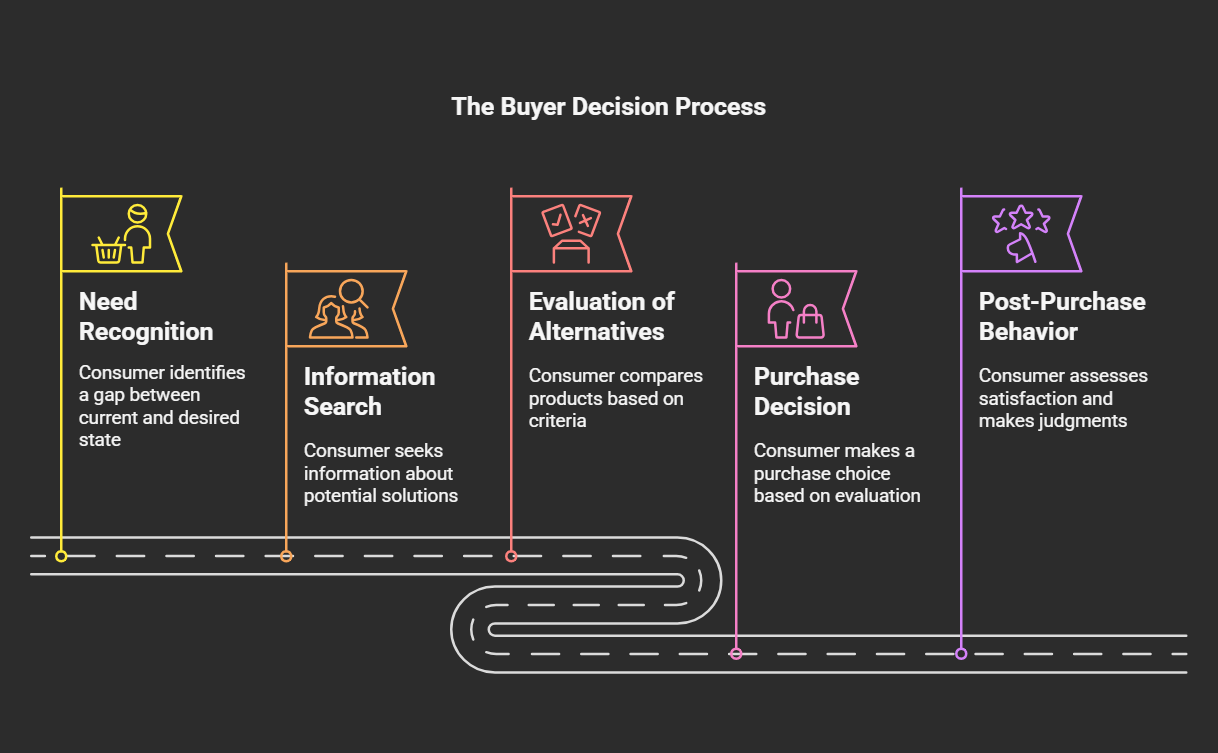The Buyer Decision Process
The Buyer Decision Process in Marketing
The buyer decision process is a fundamental concept in marketing, outlining the steps a consumer goes through when deciding to make a purchase. Understanding this process allows marketers to target their efforts more effectively. Here's a breakdown of the five stages:
1. Need Recognition
-
Definition: The initial stage where the consumer identifies a gap between their current state and a desired state. This is the trigger that initiates the buying process.
-
Triggers:
- Internal Stimuli: Basic needs like hunger, thirst, or fatigue.
- External Stimuli: Marketing efforts (ads, promotions), social influences, or changes in circumstances.
-
Examples:
- Running shoes wear out (problem recognition).
- Seeing a stylish new outfit online (want recognition).
- Feeling hungry (basic need recognition).
2. Information Search
-
Definition: Once a need is recognized, the consumer actively searches for information about potential solutions.
-
Sources:
- Internal Sources: Past experiences, memories, and personal knowledge.
-
External Sources:
- Personal sources (friends, family, colleagues).
- Commercial sources (advertising, websites, salespeople).
- Public sources (consumer reports, reviews).
- Experiential sources (product trials, samples).
-
Examples:
- Researching different brands of running shoes online.
- Asking friends for recommendations on a new restaurant.
- Reading product reviews on a retailer's website.
3. Evaluation of Alternatives
-
Definition: Consumers compare various products or brands based on their criteria and needs. They assess the pros and cons of different options.
-
Evaluation Criteria:
- Features, benefits, and quality.
- Price and value.
- Brand reputation.
- Convenience and availability.
- Personal preferences and values.
-
Examples:
- Comparing different brands of smartphones based on price, camera quality, and battery life.
- Evaluating different models of cars based on fuel efficiency, safety ratings, and features.
- Deciding between different types of coffee based on taste, origin, and price.
4. Purchase Decision
-
Definition: The stage where the consumer makes a purchase choice based on their evaluation.
-
Influencing Factors:
- Availability of the product.
- Payment options and financing.
- Store atmosphere and shopping experience.
- Unexpected situations.
-
Examples:
- Choosing a specific brand of sneakers and adding them to a shopping cart.
- Deciding to go to a particular restaurant because it has available tables.
- Making a final decision to buy a car after test driving it.
5. Post-Purchase Behavior
-
Definition: The consumer assesses their satisfaction and makes a judgment about their purchase after the transaction.
-
Key Aspects:
- Customer satisfaction or dissatisfaction.
- Cognitive dissonance (buyer's remorse).
- Word-of-mouth recommendations.
- Brand loyalty and future purchases.
-
Examples:
- Feeling happy with the new phone purchase and recommending it to others.
- Experiencing buyer's remorse after buying a product that does not meet expectations.
- Leaving a positive review for a product online and becoming a repeat customer.

